|
Pelican
This champion "little ship"
is easy to
build, sail, handle, own and love.
by William H. Short
Reprinted from "Build 20 Small Boats" - 1966
The Annual San Francisco Trans-Bay Pelican Race
has already become a popular classic. On June 11, 1966, the big
event attracted Pelicans from. all over California and Washington,
and forty-two Pelicans participated. The race to San Francisco
from Sausalito and return now includes a windward leg to test
the Pelican's tacking ability. She is smart to windward, too.
Not a single Pelican capsized or met any trouble this year, although
the afternoon breezes were fresh as ever.
Throughout the planning research for the Pelican,
the designer kept firmly in mind the challenge of San Francisco
Bay's strong winds and rough water. At the same time he was aiming
at a design simple to handle—and fast. The Pelican is a
little craft capable of safely crossing San
Francisco Bay's main ship channel west of Alcatraz (the weather
side) from Marin to San Francisco in the strong afternoon winds.
On the face of it, none of this seems impressive, until the size
and type of boat is known—a stalwart 12-foot centerboarder.
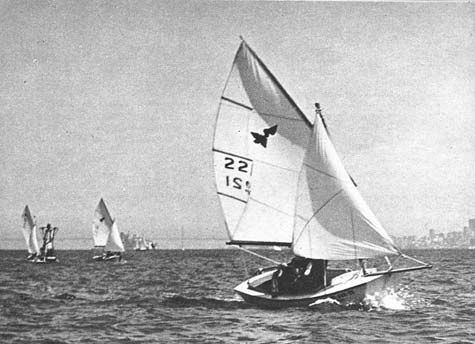
Chloe, the original
Pelican, passed all her heavy-weather channel tests with flying
colors. An article appearing in Rudder, May 1963, thoroughly describes
her sailing characteristics. Briefly, her great stability and
buoyancy are created by combining the lines of the famous Banks
fishing dory with the Oriental sampan. Foredecks, side decks and
ample stern deck, make her exceptionally dry. Real coamings around
the entire cockpit complete her corkiness. The combination of
resilient lug rig and the great flare and freeboard of her beamy
topsides make her outstandingly safe.
The Pelican can be sailed either
as a lug cat or lug stoop rig. The regular cat lug is not changed
in any way, nor is the mast shifted. Big and long, the plywood
centerhoard can he swung forward enough to balance the helm nicely,
when sailing with the jib. In brisk winds the mainsail is certainly
all that is needed. (72 sq. ft. main, not counting
large roach, and 33 sq. ft. in the jib.) She will plane and surf
serenely, often when larger boats are starting to seek shelter.
CONSTRUCTION
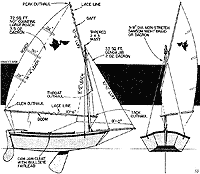
(click to enlarge) |
Basically, the hull is formed of
three sheets of plywood; only one piece for the bottom and one
panel for each side. These three sheets are joined together by
a transom bow and a transom, stern, and two longitudinals or "chine
logs" (running fore and aft inside—to connect the dory
bottom to the flaring sides). An interesting fringe benefit in
the joinery work lies in these chine logs;
their bevel angle or flare angle is CONSTANT clear fore and aft,
from stem to stern. So the chines can be ordered pre-bevelled
from the mill, and this eliminates a lot of hand faring or bevel
adjusting labor.
Pelicans
are built upside down. upon their simple (five-part) jig. Her
bow and stern transoms do double duty as hull end forms while
she is building on her jig. There are four mold forms (made of
2 x 4's and 2 x 6's, these stay with the jig). The four mold forms
and the big 2 x 12 strongback complete the building jig. No lofting
is necessary. Pelican lofts herself. The bevel angles given in
the blueprints for her chines and transom frames render it unnecessary
to loft any part of her. All bevels and dimensions have been thoroughly
proven.
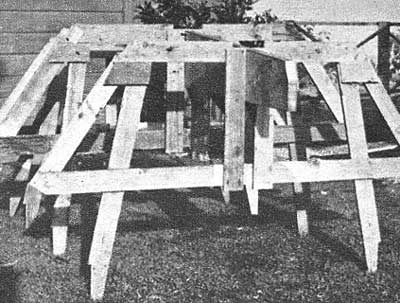
Pelicans are built upside down on simple
jig.
Transom bow and stern are end forms.
After the
6" wide laminated plywood keelson is pulled down on the strongback
with wires and turnbuckles, or ''Spanish. windlasses" (from
underneath. the jig) and transoms attached via their knees to
keelson; the prebevelled chines are bent into place over the jig
and attached to transoms. Wire and turnbuckles are used here,
too, to hold chines down while work is completed.
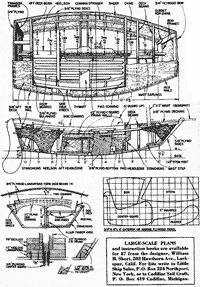 (click to enlarge)
(click to enlarge) |
Limber, straight grain air-dried
spruce is recommended for these husky
chine logs. Her chine logs are quite large in cross-section for
a 12' boat, but it's mighty nice to have a positively Weldwood-glued
and bronze-fastened bottom that will last a lifetime. Douglas
fir chines have been used, but because of its stiffness, this
material had to be laminated on 'the jig to facilitate the bending
operation. Note the unorthodox but very strong and simple method
of securing the chine ends to transoms with chine stopper blocks
of plywood, rather than notching out transom frames. This new
method eliminates a lot of awkward bevel notching, joinery work
and also guarantees a wider faying surface of transom frame near
edge of chine to prevent chances of leaking.
Next, the 2-foot wide 3/8"
thick plywood side panels are attached to the chines and the transoms.
Then the single, 3/8" -thick 4-foot wide bottom panel is
fastened in place on keelson and chines; it overlaps the side
panel. This ''planking job'' is glued and bronze boat-nailed to
keelson, to chines and transoms. Bronze "Everhold" or
"Anchorfast" serrated boat nails are faster and much
easier to use than screws and better holding in most areas. Large
screws, however, are used in very "springy" places,
like fastening the forward ends of panels to the transom frames
where one cannot easily hold down work while nailing.
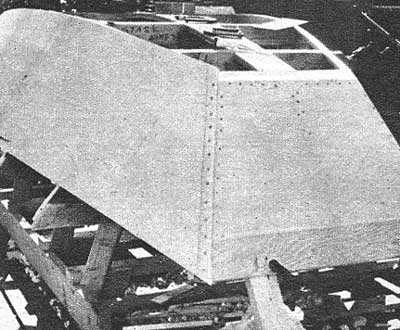
Sides are 2ft wide 3/8" plywood panels
which are glued and bronze-nailed in place.
The 6-inch wide plywood keelson,
composed of two layers of half-inch plywood, laminated down one
layer at a time, is broad enough to allow very wide trunk bedlogs
to secure to it. And the laminated down, trunk bedlogs, provide
2-inch wide surface-to-surface contact with keelson, guaranteeing
watertight integrity and tremendous laminated strength. These
bedlogs are laminated down to keelson with bronze screws. C-clamps
are placed through centerboard slot to create thorough pressure
while gluing and screwing down.
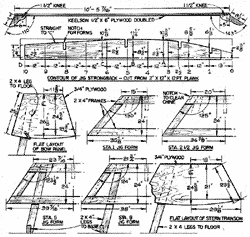 (click to enlarge)
(click to enlarge) |
Trunk headledges are not thrust
down clear through bottom of boat as in orthodox practice, but
are buried and thoroughly glued 2 inches deep between the husky
bedlogs and stand on keelson. Thus there is no end grain of headledges
exposed through bottom. Centerboard trunk panel sides are glued
and screwed to bedlogs and headledges and they, too, have a 2-inch
bury and surface to surface contact to their bedlogs. Forward
headledge is secured to main deck beam. After headledge is secured
with wide knee to keelson and to floor timber.
After the waterproof glue dries,
she is taken off the jig, turned right side up, precut sheer clamp
and the four laminated deck beams installed. These parts and the
centerboard bedlogs and trunk are all installed after the boat
is upright and off the jig.
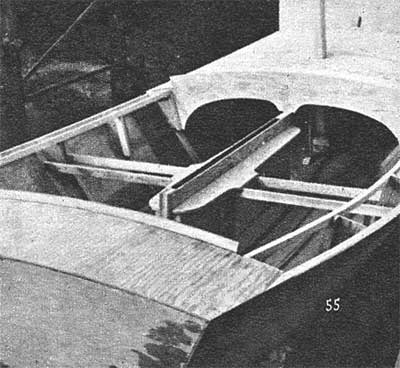
After single-sheet 4ft. wide bottom is
fastened, turn hull upright for top work.
Footlings are glued fore and aft
to the inside of the bottom of the boat to further stiffen and
provide good footing.
The deck beams are butted into
sheer clamp and attached with plywood knees to vertical frame
batten beneath sheer clamp. The only purpose of the side frame
battens is to support and secure deck beams, their knees, and
the side deck knees, and the thwart riser and
its knees.
The external stempost is not only
a strengthening member, but is used as a gammon head to snap the
plank type (plywood) bowsprit down over. Also the forestay tang
secures to it. And this stempost makes trailering easier for it
nestles into the standard trailer's winch-post bowsaddle.
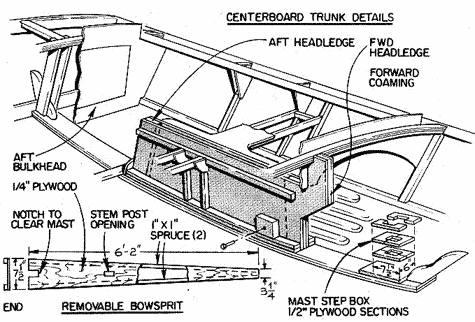
The mast is 2" x 3'' spruce.
Boom and gaff are from 2'' x 2'' spruce. Approximately 12-inch
wide plywood coamings reach deep into the cockpit and provide
great box beam and cantilever strength to the entire hull, for
they combine with the side deck knees, completing triangular box
beam rigidity.
The shrouds are 3/8-inch nonstretch
dacron rope, or nonstretch Samson Yacht Braid. The upped end of
the shroud is hung over the mast and onto the hound. The lower
end has an eye splice around a thimble so that it can be secured
by the old lanyard method to the chain plates' eye shackle. (Both
ends of the shroud are eye-spliced.) There are no gadgets or tricky
hardware in her rigging. Her chain plates are secured to the outside
of the hull, bolted with three bolts through large half-inch plywood
plate with washers and nuts on the inside. The entire boat, with
passengers, could be picked up with a crane, hooked on to a single
shroud.
The main halyard is nonstretch
3/8-inch dacron rope. The main halyard block is a 5-inch shell
and 2-3/4-inch diameter sheave, a big enough sheave so as not
to chafe the halyard through, as little sheaves will do. This
important block is hung by a 3/8-inch diameter dacron strap, choked
on to the mast over the shrouds hounds with a lark'shead bend.
The bowsprit is very quickly rigged.
When sailing the jib does not have to be rigged or set to keep
the bowsprit from sagging, for the bowsprit is thrust into place
under a hold down block on the forward edge of the mast. The regular
forestay stays with the boat whether sailing cat rigged or sloop
rigged. (This forestay is attached to the stempost tang.) The
double jib sheets lead outside and around this forestay and the
shrouds. The bowsprit bobstay is permanently spliced to the outer
end of the bowsprit but has a quick release Pelican hook that
can be secured into the towing ring eye at the bottom of the bow
transom.
|

